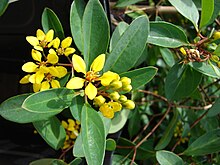
Back ملبيغية Arabic ملبيغيه ARZ Malpighiaceae AST Malpigiyakimilər Azerbaijani Малпигиеви Bulgarian Malpighiaceae BS Malpighiàcies Catalan Malpighiaceae CEB Malpígiovité Czech Barbadoskirsebær-familien Danish
| Malpighiaceae Temporal range:
| |
|---|---|

| |
| Galphimia gracilis | |
| Scientific classification | |
| Kingdom: | Plantae |
| Clade: | Tracheophytes |
| Clade: | Angiosperms |
| Clade: | Eudicots |
| Clade: | Rosids |
| Order: | Malpighiales |
| Family: | Malpighiaceae Juss.[2][3] |
| Genera | |
|
See text | |
Malpighiaceae is a family of flowering plants in the order Malpighiales. It comprises about 73 genera and 1315 species,[4] all of which are native to the tropics and subtropics. About 80% of the genera and 90% of the species occur in the New World (the Caribbean and the southernmost United States to Argentina) and the rest in the Old World (Africa, Madagascar, and Indomalaya to New Caledonia and the Philippines).
One useful species in the family is Malpighia emarginata, often called acerola. The fruit is consumed in areas where the plant is native. The plant is cultivated elsewhere for the fruit, which is rich in vitamin C.
Another member of the family, caapi or yagé (Banisteriopsis caapi), is used in the entheogenic brew known as ayahuasca.
One feature found in several members of this family, and rarely in others, is providing pollinators with rewards other than pollen or nectar; this is commonly in the form of nutrient oils (resins are offered by Clusiaceae).
- ^ "Malpighiales". www.mobot.org. Retrieved 2023-06-16.
- ^ "Malpighiaceae Juss". TROPICOS. Missouri Botanical Garden. Archived from the original on 2011-07-22. Retrieved 2010-02-02.
- ^ Angiosperm Phylogeny Group (2009). "An update of the Angiosperm Phylogeny Group classification for the orders and families of flowering plants: APG III". Botanical Journal of the Linnean Society. 161 (2): 105–121. doi:10.1111/j.1095-8339.2009.00996.x. hdl:10654/18083.
- ^ Christenhusz, M. J. M.; Byng, J. W. (2016). "The number of known plants species in the world and its annual increase". Phytotaxa. 261 (3): 201–217. doi:10.11646/phytotaxa.261.3.1.